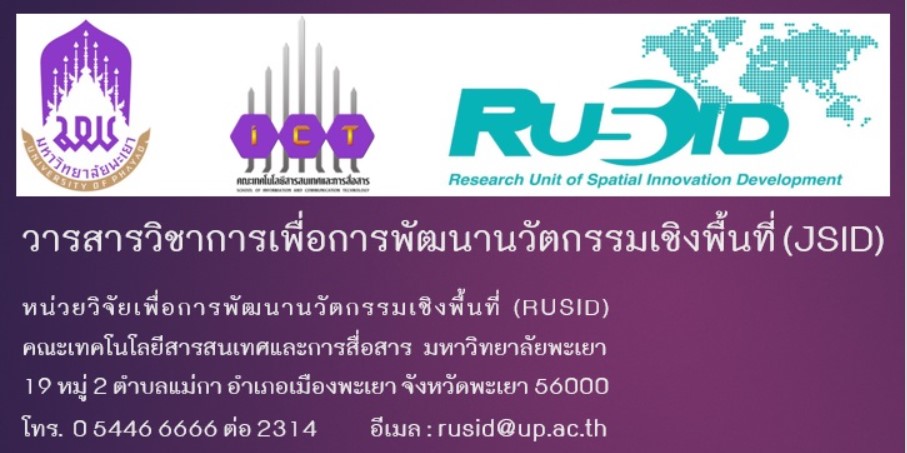บทเรียนการจัดการน้ำ: กรณีศึกษาพื้นที่ชลประทานอ่างเก็บน้ำคลองสามสิบ อำเภอเขาฉกรรจ์ จังหวัดสระแก้ว
คำสำคัญ:
การจัดการน้ำ, พื้นที่ชลประทาน, อ่างเก็บน้ำคลองสามสิบ, จังหวัดสระแก้วบทคัดย่อ
สระแก้วเป็นจังหวัดที่มีการใช้ประโยชน์พื้นที่เพื่อการเกษตรกรรมมากจังหวัดหนึ่งในภาคตะวันออก ซึ่งพื้นที่ทำการเกษตรส่วนใหญ่ได้รับน้ำจากฝนที่ตกลงมา มีเพียงบางส่วนที่ได้รับน้ำจากการชลประทานซึ่งก็จำเป็นต้องมีการบริหารจัดการน้ำที่ดี เพื่อให้เกิดการใช้น้ำอย่างมีประสิทธิภาพและไม่ก่อให้เกิดปัญหาความขัดแย้ง พื้นที่ชลประทานอ่างเก็บน้ำคลองสามสิบเป็นพื้นที่ที่โครงการชลประทานสระแก้วจัดสรรให้กับผู้ที่อยู่อาศัยเดิมก่อนมีการพัฒนาอ่างเก็บน้ำ โดยผู้ได้รับการจัดสรรได้ก่อตั้งเป็นกลุ่มผู้ใช้น้ำเพื่อบริหารจัดการน้ำที่ได้รับการจัดสรรจากโครงการชลประทานฯ และมีการบริหารจัดการกลุ่มที่เข้มแข็ง รวมทั้งไม่เกิดปัญหาหรือข้อขัดแย้งในการบริหารจัดการน้ำ ดังนั้นในการศึกษาครั้งนี้จึงเลือกพื้นที่ชลประทานอ่างเก็บน้ำคลองสามสิบเป็นพื้นที่ศึกษา เพื่อศึกษาพัฒนาการการจัดการน้ำของพื้นที่ชลประทานอ่างเก็บน้ำคลองสามสิบ อำเภอเขาฉกรรจ์ จังหวัดสระแก้ว และถอดบทเรียนความสำเร็จของการบริหารจัดการน้ำ โดยใช้วิธีการวิจัยเชิงคุณภาพด้วยวิธีการสัมภาษณ์เชิงลึก กลุ่มตัวอย่างในการสัมภาษณ์คือ คณะกรรมการกลุ่มบริหารการใช้น้ำชลประทาน อ่างเก็บน้ำคลองสามสิบ จำนวน 10 คนผลการศึกษาพบว่าการบริหารจัดการน้ำในระยะแรกได้รับการสนับสนุนจากโครงการชลประทานสระแก้วในด้านการจัดตั้งกลุ่มผู้ใช้น้ำชลประทาน และข้อมูลปริมาณน้ำชลประทานที่สามารถใช้ได้ในแต่ละปี ทำให้สามารถวางแผนการใช้น้ำได้ ต่อมากลุ่มผู้ใช้น้ำได้รวมตัวกันก่อตั้งเป็นองค์กรผู้ใช้น้ำ และมีการคัดเลือกคณะกรรมการกลุ่มบริหารการใช้น้ำชลประทาน เพื่อทำหน้าที่ในการบริหารจัดการ กลุ่มผู้มีส่วนได้ส่วนเสียในการบริหารจัดการน้ำ จำแนกได้เป็น 5 กลุ่ม คือ กลุ่มผู้ใช้น้ำ นักวิจัย/นักวิชาการ องค์การปกครองส่วนท้องถิ่น โครงการชลประทานสระแก้ว และกรมป่าไม้ ซึ่งแต่ละกลุ่มมีบทบาท ระดับความสนใจ และระดับอิทธิพลต่อการบริหารจัดการน้ำต่างกันไป โดยกลุ่มที่มีระดับความสนใจมากที่สุด คือ กลุ่มผู้ใช้น้ำ และกลุ่มที่มีอิทธิพลต่อการบริหารจัดการน้ำมากที่สุด คือ โครงการชลประทาน เนื่องจากเป็นหน่วยงานที่รับผิดชอบหลักในการจัดหาและส่งน้ำตามภารกิจและหน้าที่ที่ได้รับมอบหมาย ปัจจัยความสำเร็จของการบริหารจัดการน้ำประกอบด้วย โครงสร้างและความเข้มแข็งของการรวมตัวและบริหารจัดการการใช้น้ำ และการสนับสนุนข้อมูลเพื่อการบริหารจัดการจากโครงการชลประทานสระแก้ว ส่วนปัจจัยจำกัดของการบริหารจัดการน้ำ ประกอบด้วยทักษะและงบประมาณในการบำรุงรักษาระบบส่งน้ำและอุปกรณ์ และองค์ความรู้ในการคาดการณ์และประเมินความต้องการน้ำในภาวะวิกฤตรวมทั้งการกำหนดมาตรการในการตอบสนอง
เอกสารอ้างอิง
กชกร เดชะคำภู. (2560). รูปแบบการพัฒนาการมีส่วนร่วมในการบริหารจัดการทรัพยากรน้ำของผู้ใช้น้ำ โครงการพัฒนาลุ่มน้ำก่ำอันเนื่องมาจากพระราชดำริ (รัฐประศาสนศาสตรดุษฎีบัณฑิต). สาขาวิชารัฐประศาสนศาสตร์, มหาวิทยาลัยราชภัฎมหาสารคาม, มหาสารคาม.
จันทิรา สุขศิวานันท์. (2561). การมีส่วนร่วมของประชาชนในการบริหารจัดการทรัพยากรน้ำ: ศึกษากรณีลุ่มน้ำคลองอู่ตะเภา จังหวัดสงขลา. สืบค้นจาก http://www.ba-abstract.ru.ac.th/.
บัญชา ขวัญยืน, จุติเทพ วงษ์เพ็ชร์ และ ไชยาพงษ์ เทพประสิทธิ์ และคณะ. (2563). การบริหารและการประมวลผลการศึกษาโครงการวิจัยเพื่อจัดทำข้อเสนอแนะสมดุลน้ำและมาตรการลดการใช้น้ำเพื่อการพัฒนาอย่างยั่งยืนในการพัฒนาระเบียงเศรษฐกิจพิเศษภาคตะวันออก (EEC) [รายงานวิจัยฉบับสมบูรณ์], กรุงเทพฯ: มหาวิทยาลัยเกษตรศาสตร์.
สำนักงานคณะกรรมการน้ำแห่งชาติ. (2566). พระราชกฤษฎีกากำหนดลุ่มน้ำ พ.ศ.2564. สืบค้นจาก http://www.onwr.go.th/?page_id=4184.
สำนักงานคณะกรรมการพิเศษเพื่อประสานงานโครงการอันเนื่องมาจากพระราชดำริ, (2566). โครงการอ่างเก็บน้ำคลองสามสิบอันเนื่องมาจากพระราชดำริ.
สำนักงานจังหวัดสระแก้ว. (2559). แผนพัฒนาจังหวัดสระแก้ว. สืบค้นจาก http://sakaeo.go.th/oldwebsakaeo/news/news_file/103Oct20161475466688232599plan%204%20(2561-2564).pdf.
Denizen, N. K. (1970). The research act: A theoretical introduction to sociological methods. Chicago, IL: Aldine.
Yoo, S.H., Choi, J.Y., Lee, S.H., Oh, Y.G., and Yun D.K. (2013). Climate change impacts on water storage requirements of an agricultural reservoir considering changes in land use and rice growing season in Korea. Agricultural Water Management. 117, 43-54.





